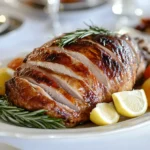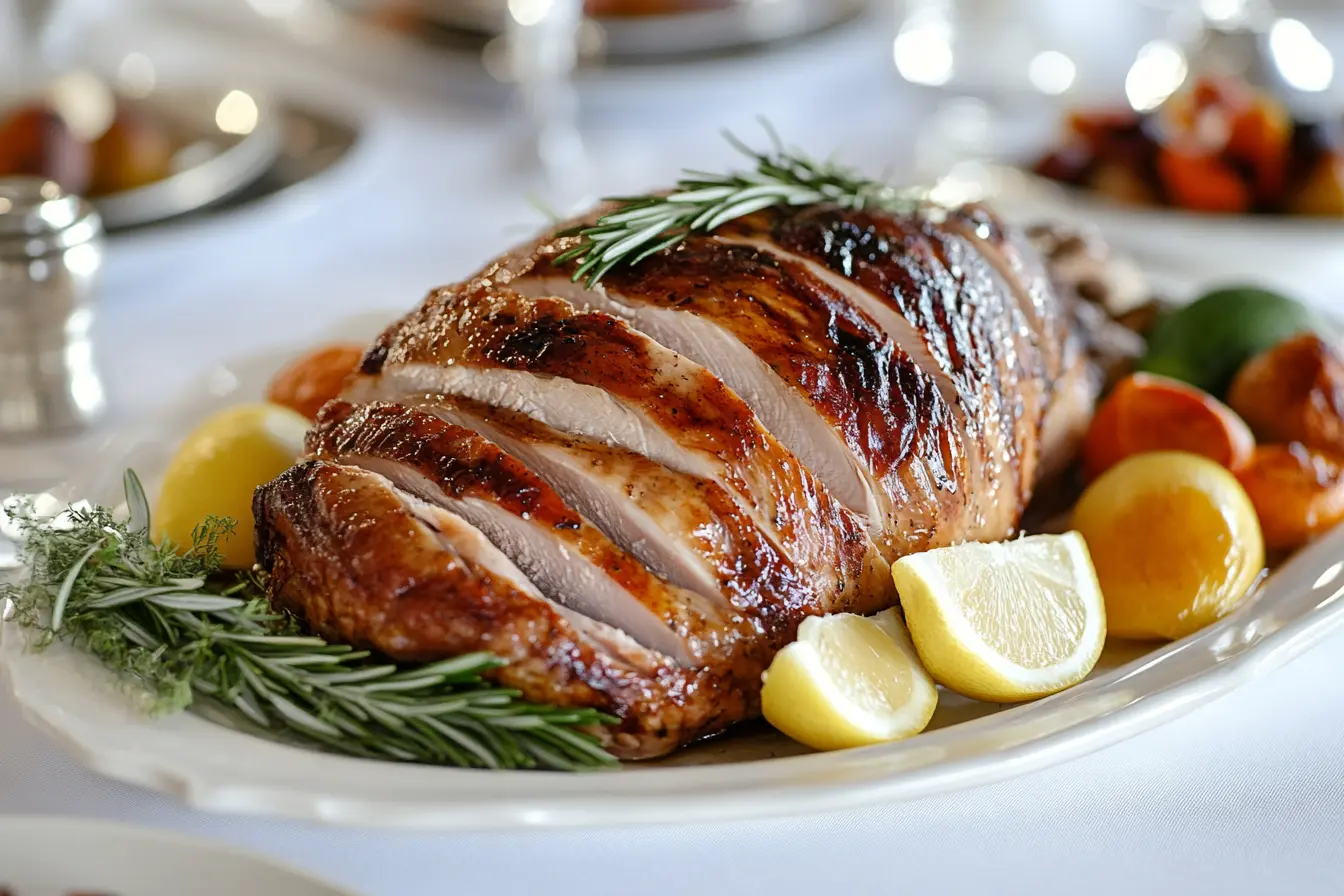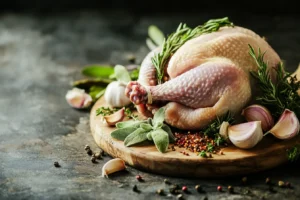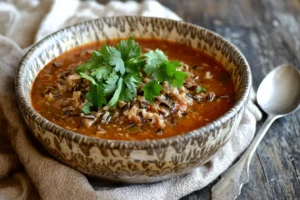Cooking wild turkey is both an adventure and an art. Whether you’re an avid hunter or someone who enjoys game meat, wild turkey recipes provide an exciting way to explore bold flavors and healthy meals. In this guide, we’ll cover everything from preparation tips to creative ways to transform leftovers, ensuring your next meal is a culinary masterpiece.
Introduction to Wild Turkey Cooking
Understanding Wild Turkey Meat
Wild turkey meat is lean, flavorful, and distinct from its domestic counterpart. Packed with protein and lower in fat, it’s a healthy alternative to traditional poultry. But because of its lean nature, it requires thoughtful preparation to avoid dryness and enhance flavor. Compared to domestic turkeys, wild turkeys offer a richer, more game-like taste, making them perfect for adventurous cooks.
Differences Between Wild and Domestic Turkey
The primary difference lies in texture and fat content. Unlike farm-raised turkeys, wild turkeys roam freely, resulting in firmer meat. This difference makes cooking techniques like slow roasting, brining, or marinating essential to maintain tenderness. Additionally, wild turkey is typically smaller, with less breast meat but equally tasty cuts in the legs and thighs.
Importance of Proper Preparation
Preparing wild turkey correctly can make or break your meal. From field dressing to seasoning, every step plays a role in achieving the best flavor. Some swear by dry rubs, while others prefer wet marinades; either way, taking time to prepare the bird properly ensures it stays moist and tender.
Cooking wild turkey is about more than just following a recipe—it’s a celebration of its natural flavors. With the right approach, this versatile bird can shine in countless dishes, making it a hit on any table.
For another unique take on poultry, explore this recipe for Red Lobster-inspired Brussels sprouts to serve as a side dish with wild turkey.
Preparing Wild Turkey for Cooking
Field Dressing and Processing Wild Turkey
When it comes to preparing wild turkey recipes, proper field dressing and processing are crucial steps. First and foremost, handling the bird with care ensures that the meat remains uncontaminated. This process begins immediately after harvesting. By removing internal organs and cleaning the cavity, you lay the foundation for a safe and flavorful meal. It’s important to let the meat cool quickly, as this prevents spoilage and retains its natural texture.
Notably, while processing might seem daunting at first, it’s easier with practice. You’ll want to separate the meat into manageable portions, focusing on the breast, thighs, and legs.
Brining Techniques for Moisture Retention
Because wild turkey is leaner than its domestic counterpart, brining is a game-changer. A well-prepared brine adds moisture and enhances flavor, preventing the meat from drying out during cooking. Whether you use a classic saltwater solution or one infused with herbs and spices, brining ensures the turkey stays juicy and tender.
Additionally, brining isn’t just about adding water. Spices like garlic, bay leaves, and rosemary work wonders in complementing the rich, earthy taste of wild turkey. Allowing the bird to soak for 12–24 hours in the refrigerator ensures the flavors penetrate deep into the meat.
Seasoning and Marinades for Wild Turkey
Seasoning brings out the best in any wild turkey recipe. For a bold, smoky flavor, dry rubs with paprika, garlic powder, and black pepper are excellent choices. Alternatively, marinades combine liquids like citrus juice or soy sauce with aromatic herbs, infusing the meat with complex flavors.
While some prefer simplicity, others enjoy experimenting with combinations that include honey, mustard, or chili flakes. Whatever approach you take, ensure that the seasoning complements the natural flavor of the turkey rather than overpowering it.
Enhance your wild turkey with spice blends inspired by this smoky chicken tomato bisque recipe.
In essence, the way you prepare your wild turkey determines the final outcome. From field dressing to brining and seasoning, each step adds a layer of care that translates into a delicious meal on your plate.
Popular Wild Turkey Recipes
Grilled Wild Turkey Breast
Grilling is one of the easiest and most flavorful ways to cook wild turkey breast. First, start by marinating the meat with olive oil, lemon juice, and your favorite herbs for at least two hours. This not only tenderizes the meat but also enhances its natural flavors. Next, preheat the grill and ensure the grates are oiled to prevent sticking. Then, place the turkey breast on the grill over medium heat, flipping it occasionally to achieve even cooking.
What’s more, grilling locks in moisture and creates a smoky char that pairs wonderfully with side dishes like roasted vegetables or a crisp salad. The result is a juicy, tender cut of meat that truly shines in wild turkey recipes. And here’s a tip: let the grilled turkey rest for a few minutes before slicing to allow the juices to redistribute.
Wild Turkey Gumbo
If you’re craving something hearty, wild turkey gumbo is the answer. Packed with bold Cajun flavors, this dish makes excellent use of turkey legs and thighs. To begin, sauté vegetables like onions, bell peppers, and celery in oil, then add flour to create a rich roux. After that, stir in your turkey pieces, chicken stock, and a blend of spices such as cayenne, thyme, and paprika.
As the gumbo simmers, the flavors meld beautifully, turning the lean turkey into a tender, flavorful addition to the dish. Serve it over steamed rice for a satisfying, warming meal.
Smoked Wild Turkey Legs
Smoking wild turkey legs creates a dish that’s bursting with flavor. First, apply a dry rub made from brown sugar, chili powder, and garlic to the turkey legs. Then, set your smoker to a low temperature, around 225°F, and add wood chips for extra smokiness. Allow the legs to smoke for 2–3 hours, basting them occasionally with a mix of apple juice and butter for added moisture.
The result? Smoky, fall-off-the-bone meat that’s perfect as a main dish or paired with cornbread. Smoked turkey legs are not just delicious but also a great way to showcase the unique taste of wild game.
With these wild turkey recipes, you can explore a variety of cooking techniques while celebrating the natural flavors of this exceptional meat.
Creative Uses for Wild Turkey Leftovers
Wild Turkey Soup with Wild Rice
After a feast, leftover wild turkey can easily transform into a comforting and nutritious soup. Begin by shredding any leftover turkey and setting it aside. In a large pot, sauté onions, carrots, and celery until tender. Then, add chicken broth, bay leaves, and a generous portion of wild rice. Once the rice begins to soften, stir in the shredded turkey and season with thyme, garlic, and a pinch of salt.
This soup is not only hearty but also incredibly versatile. You can adjust the ingredients based on what you have available, making it perfect for improvising. Plus, the wild rice adds a nutty flavor that pairs beautifully with the richness of the turkey, turning simple leftovers into a gourmet dish.
Turkey and Stuffing Meatballs
If you’re looking for something creative, why not turn those leftovers into wild turkey meatballs? By combining shredded turkey, leftover stuffing, and a whisked egg, you can quickly form the mixture into small balls. Afterward, bake them in the oven until golden brown. These meatballs are excellent as appetizers or served with cranberry sauce for a fun twist on classic holiday flavors.
The best part about these meatballs is their adaptability. You can season them with fresh herbs like sage or rosemary for an extra burst of flavor. They’re also a great way to use up every bit of your meal while still creating something entirely new.
Wild Turkey Pot Pie
A pot pie is the epitome of comfort food, and using leftover wild turkey makes it even better. Start by preparing a creamy sauce with butter, flour, and milk, then add chopped turkey, peas, carrots, and any other vegetables you like. Pour the mixture into a pie crust, top it with another layer of dough, and bake until golden brown.
Not only is this dish delicious, but it also freezes well, making it ideal for meal prep. Every bite combines flaky crust, savory turkey, and creamy filling, which is a surefire way to please the entire family.
Transform leftovers into a unique meal by taking cues from this creamy turkey cabbage casserole recipe.
These leftover ideas prove that wild turkey recipes can be as versatile as they are delicious. With just a little creativity, you can turn yesterday’s meal into a brand-new culinary adventure.
Nutritional Information and Considerations
Calorie and Protein Content in Wild Turkey
Wild turkey is celebrated for its exceptional nutritional profile. It’s a lean source of protein, with a 3-ounce serving of wild turkey breast providing about 26 grams of protein and less than 1 gram of fat. This makes it an excellent option for building muscle, boosting energy, and maintaining a healthy lifestyle. Furthermore, its low calorie content ensures it fits seamlessly into weight-conscious meal plans.
In contrast to fatty cuts of other meats, wild turkey is naturally lean, meaning it doesn’t require excessive seasoning or preparation to shine. Its nutritional value makes it a popular choice for those seeking health-conscious wild turkey recipes.
Differences Between Wild and Farm-Raised Turkey
Compared to farm-raised turkey, wild turkey is significantly leaner due to its active lifestyle. The free-ranging diet of wild turkeys results in meat that’s higher in nutrients like B vitamins, selenium, and zinc. Meanwhile, farm-raised birds tend to contain more fat due to their controlled diets and limited mobility.
Interestingly, the flavor of wild turkey is often richer and more robust, which reduces the need for heavy sauces or seasonings. This not only enhances its health benefits but also highlights its unique gamey taste. For those aiming to avoid unnecessary additives, wild turkey recipes are a cleaner and more natural option.
Health Benefits of Wild Turkey
Wild turkey’s nutritional advantages extend beyond calories and protein. It’s packed with selenium, an essential mineral for immune support and thyroid health. Its low cholesterol levels make it a heart-healthy choice, while its rich concentration of vitamins, including B6 and niacin, aids in energy production and metabolism.
Additionally, wild turkey is free from hormones and antibiotics commonly found in farm-raised poultry. Including it in your diet allows you to enjoy a wholesome, natural protein that’s as nutritious as it is delicious. Whether you’re following a specific diet or simply prioritizing clean eating, wild turkey recipes offer a flavorful way to meet your health goals.
Frequently Asked Questions About Wild Turkey Recipes
How Do You Keep Wild Turkey from Drying Out?
One of the biggest challenges when preparing wild turkey recipes is keeping the meat moist. Since wild turkey is leaner than domesticated varieties, it tends to dry out quickly if not cooked properly. Brining is one of the best methods to retain moisture. By soaking the turkey in a solution of salt, water, and optional herbs for several hours, you allow the meat to absorb and lock in liquid. Additionally, slow cooking methods like roasting at a low temperature or using a smoker help preserve juiciness.
Moreover, resting the turkey after cooking is crucial. Letting it sit for 10–15 minutes allows the juices to redistribute, which prevents dryness when slicing. Using marinades or basting during cooking also adds layers of flavor while maintaining tenderness.
What Are the Best Cooking Methods for Wild Turkey?
The best cooking methods for wild turkey recipes depend on the cut you’re using. For the breast, grilling or pan-searing works wonderfully to enhance its natural flavors. Meanwhile, tougher cuts like the legs and thighs benefit from slow cooking or braising. These methods break down the connective tissues, resulting in tender, flavorful meat.
Smoking is another popular option, as it infuses the meat with a rich, smoky aroma. Whether you’re preparing a whole turkey or individual parts, low-and-slow techniques are generally the safest bet for ensuring moist and flavorful results.
Can You Substitute Wild Turkey in Any Turkey Recipe?
Yes, you can absolutely substitute wild turkey in any recipe that calls for domesticated turkey. However, keep in mind that its leaner texture may require adjustments in cooking time and seasoning. For instance, recipes like turkey chili, casseroles, or soups can easily accommodate wild turkey meat, provided you take steps to keep it moist.
Whether you’re grilling, roasting, or slow-cooking, adapting recipes to use wild turkey adds a delicious twist to familiar dishes. By following a few simple techniques, you can enjoy the versatility of this healthy, flavorful game meat in countless meals.
Conclusion and Additional Tips
Summary of Key Points
Wild turkey offers an exciting and nutritious alternative to traditional poultry, with its lean protein and bold, gamey flavor. Throughout this guide, we’ve explored every aspect of cooking wild turkey recipes, from preparation techniques to creative leftover ideas. Whether you’re grilling a breast, smoking legs, or crafting a hearty soup, each method celebrates the unique qualities of this versatile meat.
Importantly, preparation plays a critical role in the success of these recipes. Brining, proper seasoning, and slow cooking not only enhance the flavor but also prevent the meat from drying out. Additionally, embracing the distinctive taste of wild turkey allows you to elevate classic dishes with ease.
Additional Cooking Tips
To get the most out of your wild turkey recipes, remember to tailor your approach based on the cut of meat. For example, grilling or pan-searing works best for tender cuts like the breast, while slow cooking or braising transforms tougher cuts like legs and thighs into melt-in-your-mouth dishes. Using marinades, rubs, and herbs further enhances the natural flavors of the turkey without overpowering it.
Another valuable tip is to let the meat rest after cooking. By doing so, you allow the juices to redistribute, which ensures every bite remains moist and flavorful. And don’t shy away from experimenting with spices and side dishes—pairing turkey with fresh vegetables, wild rice, or herbs can add even more depth to your meal.
Encouragement to Experiment with Recipes
Cooking wild turkey is a journey of discovery, where each recipe allows you to unlock new flavors and techniques. While there are tried-and-true methods, don’t hesitate to explore and adapt recipes to suit your taste. Whether you’re preparing a family meal or hosting a special gathering, wild turkey recipes can make any occasion memorable.
So, grab your ingredients, embrace the challenge, and savor the rich taste of wild game. The possibilities are endless, and with a little creativity, your next meal could become a new favorite!
Print
The Ultimate Guide to Wild Turkey Recipes: Delicious and Healthy Cooking Tips
- Total Time: 35 minutes
- Yield: 4 servings 1x
Description
A flavorful and juicy grilled wild turkey breast recipe, perfect for showcasing the natural taste of wild game with minimal effort.
Ingredients
- 1 wild turkey breast
- 1/4 cup olive oil
- 2 tbsp lemon juice
- 2 cloves garlic, minced
- 1 tsp paprika
- 1 tsp black pepper
- 1 tsp salt
- 1 tsp dried thyme
Instructions
- Prepare the Marinade: In a bowl, whisk together olive oil, lemon juice, garlic, paprika, black pepper, salt, and thyme.
- Marinate the Turkey: Place the turkey breast in a resealable plastic bag or shallow dish. Pour the marinade over the turkey, ensuring it is well coated. Marinate in the refrigerator for at least 2 hours or overnight for best results.
- Preheat the Grill: Heat the grill to medium heat and oil the grates to prevent sticking.
- Grill the Turkey: Remove the turkey from the marinade and let any excess drip off. Place it on the grill and cook for 6–8 minutes per side or until the internal temperature reaches 165°F (74°C).
- Rest and Serve: Remove the turkey from the grill and let it rest for 5 minutes. Slice and serve with your favorite side dishes.
- Prep Time: 15 minutes
- Cook Time: 20 minutes
- Category: Main Course
- Method: Grilling
- Cuisine: American
Nutrition
- Serving Size: per serving
- Calories: 220
- Sugar: 0g
- Sodium: 480mg
- Fat: 8g
- Saturated Fat: 1.5g
- Carbohydrates: 1g
- Fiber: 0g
- Protein: 38g
- Cholesterol: 85mg
Keywords: game meat recipes, cooking wild turkey, turkey breast recipes, wild turkey cooking ideas, preparing wild turkey


